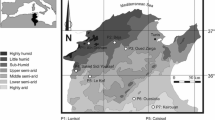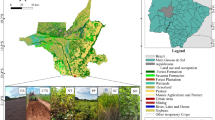Abstract
Recent studies in temperate regions have shown that the increase in C stocks in surface soil layers does not respond linearly to C addictions over time, due to a saturation of the sorption sites. The obtained results have indicated that deeper soil layers may act as important C sink. The aim of this study was to investigate the influence of soil management system on the C retention capacity and on the composition of soil organic matter (SOM) in silt and clay fractions of two subtropical oxisols. Soil samples were collected in profiles (0–100 cm) of a brown oxisol (BO) and of a red oxisol (RO), cultivated for 30 years under no-tillage (NT) and conventional tillage (CT), and from a neighbouring area under native forest (NF) as a reference for the original carbon content. After removal of particulate organic matter, the suspension (<53 μm) was sonicated, and silt and clay fractions were separated according to Stokes’ law. Carbon content of the whole soil and of the fractions was determined by dry combustion, and SOM composition was investigated by means of FTIR spectroscopy, employing multicomponent analysis. The silt fraction under NF showed a higher capacity of C retention than the clay fraction in both oxisols. The same behaviour was shown by CT and NT from the RO, while for the BO C, content in the clay fraction was always greater than that in the silt fraction. It follows that the mechanism for C sequestration differed in the two soils. In both soils, approximately 70% of the soil C was stored in the layer between 20 and 100 cm.
Access provided by Autonomous University of Puebla. Download conference paper PDF
Similar content being viewed by others
Keywords
Introduction
In the last decades, studies about the influence of no-tillage system on the increase of soil C stocks have been conducted mostly within the top 5- to 20-cm soil layer. In general, these studies verified that each soil has a finite capacity to retain C, and this behaviour is related mainly to soil texture and to the reactivity of mineral surfaces (Stewart et al. 2007, 2008, 2009). Based on this concept, the capacity of soil to sequestrate C would be solely related the formation of organo-mineral complexes. Nevertheless, other mechanisms like self-assembly of organic molecular moieties and the accumulation of C in deeper layers have been also proposed to explain the potential of soil as a C sink (Kleber et al. 2007; Kleber and Johnson 2010). Therefore, the scope of this study was to investigate the influence of soil management system on the C retention capacity of silt and clay fractions in two subtropical oxisols cultivated for 30 years under no-tillage (NT) and conventional tillage (CT) and to estimate its maximal value.
Materials and Methods
Samples (three field replicates) were collected from two long-term experiments of a brown oxisol (BO) and of a red oxisol (RO) in south Brazil under no-tillage (NT) and conventional tillage (CT) in the following depths: 0–2.5, 2.5–5, 5–10, 10–20, 40–60 and 80–100 cm. Samples from native forest (NF) in each site were used as reference of the indigenous vegetation. After removal of particulate organic matter (POM) by sieving, the suspension (<53 μm) was sonicated (1,500 J mL−1), and silt and clay fractions were separated according to Stokes’ law. The silt fraction was further submitted to density fractionation with sodium polytungstate solution (ρ = 2.0 g cm−3) for the removal of the light fraction (LF), resulting in a LF-free silt fraction. The C and N contents of the whole soil and of the fractions were determined by dry combustion. The maximal C retention capacity was estimated from the mathematical models fitted to the plot between the C content in each fraction and \( {C_{\mathrm{ soil}}}\left( {{C_{\mathrm{ fraction}}}={a-b \left/ {{{C_{\mathrm{ soil}}}}} \right.}\ \mathrm{ or}\;{C_{\mathrm{ fraction}}}=a+{b^{*}}\left[ {1-{{\mathrm{ e}}^{{\left( {-{c^{*}}{C_{\mathrm{ soil}}}} \right)}}}} \right]} \right). \) The chemical composition of the soil organic matter (SOM) in each fraction was investigated by FTIR spectroscopy, and the data were analysed by principal component analysis (PCA).
Results and Discussion
In the BO soil, the soil under NT showed higher soil C stocks until 5 cm depth in comparison to CT, while in the RO soil, this difference occurred only in the 0–2.5-cm layer. Regardless the management system, about 29–32% of the total soil C stock of the 0–100 cm depth was accumulated in the top 0–20-cm layer, in both oxisols. The C saturation level estimated for the silt fraction under forest exceeded that of the clay fraction in about 50% for the BO and 200% for the RO (Figs. 1 and 2). After removal of the LF, C saturation of the silt fraction in NF decreased but still remained higher than that in the clay fraction in both soils (Table 1). Similar behaviour was shown by the RO soil under CT and NT, while in the agricultural BO soils, a greater C saturation was found in the clay fraction.
Conclusions
The retention of SOM in oxisols may be explained by two main processes: the sorption of organic compounds directly on the mineral surface sites and a sorption of SOM on previously sorbed organic coating, leading to a self-association micelle-like structure. The second mechanism plays an important role under CT and NT in the RO soil and under NF in both soils. In the BO soil, both mechanisms seem to contribute equally to C sequestration. Our results elucidate the importance of SOM composition in the C sequestration mechanisms.
References
Kleber, M., and M.G. Johnson. 2010. Advances in understanding the molecular structure of soil organic matter: Implications for interactions in the environment. Advances in Agronomy 106: 77–142.
Kleber, M., P. Sollins, and R. Sutton. 2007. A conceptual model of organo-mineral interactions in soils: Self-assembly of organic molecular fragments into zonal structures on mineral surfaces. Biogeochemistry 85: 9–24.
Stewart, C.E., K. Paustian, R.T. Conant, A.F. Plante, and J. Six. 2007. Soil carbon saturation: Concept, evidence and evaluation. Biogeochemistry 86: 19–31.
Stewart, C.E., A.F. Plante, K. Paustian, R.T. Conan, and J. Six. 2008. Soil carbon saturation: Linking concept and measurable carbon pools. Soil Science Society of America Journal 72: 379–392.
Stewart, C.E., K. Paustian, R.T. Conant, A.F. Plante, and J. Six. 2009. Soil carbon saturation: Implications for a measurable carbon pool dynamics in long-term incubations. Soil Biology and Biochemistry 41: 357–366.
Acknowledgements
CNPq and Capes.
Author information
Authors and Affiliations
Corresponding author
Editor information
Editors and Affiliations
Rights and permissions
Copyright information
© 2013 Zhejiang University Press and Springer Science+Business Media Dordrecht
About this paper
Cite this paper
Dick, D.P., Reis, C.S., Bayer, C., Caldas, J.S. (2013). Carbon Sequestration in Subtropical Oxisol Profiles: Retention Capacity and Effect of Soil Management. In: Xu, J., Wu, J., He, Y. (eds) Functions of Natural Organic Matter in Changing Environment. Springer, Dordrecht. https://doi.org/10.1007/978-94-007-5634-2_64
Download citation
DOI: https://doi.org/10.1007/978-94-007-5634-2_64
Published:
Publisher Name: Springer, Dordrecht
Print ISBN: 978-94-007-5633-5
Online ISBN: 978-94-007-5634-2
eBook Packages: Earth and Environmental ScienceEarth and Environmental Science (R0)






